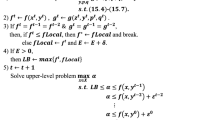Abstract
This paper addresses a special kind of network optimization interdiction problems, called the shortest path interdiction problem. The problem is a natural extension of the well-known shortest path problem in the presence of an adversary. The adversary is capable of increasing arc lengths under budget and bound constraints in a way that the shortest path length between two prescribed nodes becomes large as much as possible. This paper considers the problem in the case that the increment costs are convex piecewise-linear functions. It presents an algorithm which solve the problem in polynomial time. An applicable example and several randomly generated instances are presented to evaluate the performance and validity of the proposed algorithm.







Similar content being viewed by others
References
Abdolahzadeh A, Aman M, Tayyebi J (2020) Minimum st-cut interdiction problem. Comput Indus Eng 148:106708
Abdolahzadeh A, Aman M, Tayyebi J (2021) Communication Line Protection Against Sabotages Using Dynamic Minimum Cut Interdiction. J Adv Defense Sci Technol 12(2):205–215 ((in persian))
Ahuja RK, Magnanti TL, Orlin JB (1993) Network flows: Theory, applications and algorithms, Englewood Cliffs, New Jersey, USA Arrow, KJ: Prentice-Hall
Assimakopoulos N (1987) A network interdiction model for hospital infection control. Comput Biol Med 17:413–422
Bayrak H, Bailey MD (2008) Shortest path network interdiction with asymmetric information. Netw Int J 52(3):133–140
Bazaraa MS, Jarvis JJ, Sherali HD (2008) Linear programming and network flows. Wiley, Hoboken
Bazgan C, Toubaline S, Vanderpooten D (2013) Critical edges/nodes for the minimum spanning tree problem: complexity and approximation. J Comb Optim 26(1):178–189
Britannica T Editors of Encyclopaedia (2022, January 9) Persian Gulf War. Encyclopedia Britannica. https://www.britannica.com/event/Persian-Gulf-War. Accessed 2 2023
Boeckmann J, Thielen C (2021) A \((B+1)\)-approximation for network flow interdiction with unit costs. Discrete Appl Math. https://doi.org/10.1016/j.dam.2021.07.008
Borrero JS, Prokopyev OA, Sauré D (2016) Sequential shortest path interdiction with incomplete information. Decis Anal 13(1):68–98
Brown G, Carlyle M, Salmeron J, Wood K (2006) Defending critical infrastructure. Informs 36(6):530–544
Erdõs P, Rényi A (1976) On the evolution of random graphs. Selected Papers of Alfréd Rényi 2:482–525
Fulkerson DR, Harding GC (1977) Maximizing the minimum source-sink path subject to a budget constraint. Math Program 13(1):116–118
Golden B (1978) A problem in network interdiction. Naval Res Logistics Q 25(4):711–713
Israeli E, Wood RK (2002) Shortest-path network interdiction. Netw Int J 40(2):97–111
Kleinert T, Labbé M, Ljubić I, Schmidt M (2021) A survey on mixed-integer programming techniques in bilevel optimization. EURO J Comput Optimization 9:100007
Malaviya A, Rainwater C, Sharkey TC (2012) Multi-period network interdiction problems with applications to city-level drug enforcement. IIE Trans 44(5):368–380
Mirzaei M, Al-e SMJM, Shirazi MA (2021) A maximum-flow network interdiction problem in an uncertain environment under information asymmetry condition: Application to smuggling goods. Comput Indus Eng 162:107708
Mohammadi A, Tayyebi J (2019) Maximum capacity path interdiction problem with fixed costs. Asia-Pacific J Oper Res 36(04):1950018
Ramirez-Marquez JE (2010) A bi-objective approach for shortest-path network interdiction. Comput Indus Eng 59(2):232–240
Sadati MEH, Aksen D, Aras N (2020) A trilevel r-interdiction selective multi-depot vehicle routing problem with depot protection. Comput Operat Res 123:104996
Sadeghi S, Seifi A, Azizi E (2017) Trilevel shortest path network interdiction with partial fortification. Comput Indus Eng 106:400–411
Schäfer LE, Dietz T, Natale MV, Ruzika S, Krumke SO, Fonseca CM (2020) The Bicriterion Maximum Flow Network Interdiction Problem in s-t-Planar Graphs. In: Operations Research Proceedings 2019 (pp 133-139). Springer, Cham
Sefair JA, Smith JC (2016) Dynamic shortest-path interdiction. Networks 68(4):315–330
Smith JC, Lim C (2008) Algorithms for network interdiction and fortification games. In: Pareto optimality, game theory and equilibria (pp 609-644). Springer, New York
Smith JC, Song Y (2020) A survey of network interdiction models and algorithms. Eur J Oper Res 283(3):797–811
Vanderbei RJ (2020) Linear programming. Springer International Publishing, New York
Washburn A (2014) Two-Person Zero-Sum Games. International Series in Operations Research and Management Science, Springer, The fourth edition
Wei N, Walteros JL, Pajouh FM (2021) Integer programming formulations for minimum spanning tree interdiction. INFORMS J Comput 33(4):1461–1480
Xiao K, Zhu C, Zhang W, Wei X (2020) The Bi-Objective Shortest Path Network Interdiction Problem: Subgraph Algorithm and Saturation Property. IEEE Access 8:146535–146547
Yang J, Borrero JS, Prokopyev OA, Sauré (2021) Sequential shortest path interdiction with incomplete information and limited feedback. Decis Anal 18(3):218–244
Zhang Q, Guan X, Pardalos PM (2021) Maximum shortest path interdiction problem by upgrading edges on trees under weighted \(l_1\) norm. J Global Optim 79(4):959–987
Author information
Authors and Affiliations
Corresponding author
Additional information
Communicated by Margherita Porcelli.
Publisher's Note
Springer Nature remains neutral with regard to jurisdictional claims in published maps and institutional affiliations.
Rights and permissions
Springer Nature or its licensor (e.g. a society or other partner) holds exclusive rights to this article under a publishing agreement with the author(s) or other rightsholder(s); author self-archiving of the accepted manuscript version of this article is solely governed by the terms of such publishing agreement and applicable law.
About this article
Cite this article
Tayyebi, J., Deaconu, A.M., Bigdeli, H. et al. Shortest path interdiction problem with convex piecewise-linear costs. Comp. Appl. Math. 42, 309 (2023). https://doi.org/10.1007/s40314-023-02445-0
Received:
Revised:
Accepted:
Published:
DOI: https://doi.org/10.1007/s40314-023-02445-0




